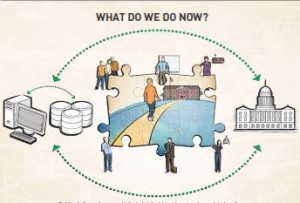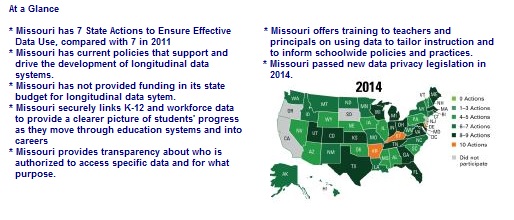Student Privacy Pledge
The Future of Privacy Forum and the Software & Information Industry Association facilitated a K-12 school service providers’ Pledge to safeguard student privacy. The commitments detail ongoing industry practices that meet and go beyond federal requirements and encourage school service providers to clearly articulate these practices to ensure confidence in how they handle student data.
View the pledge, endorsers, and see who’s signed the pledge at www.studentprivacypledge.org
Data: The Missing Piece to Improving Student Achievement – This interactive guide published by the Data Quality Campaign discusses what is data, how will it help, and the communities (parents & students, teachers, school administrators, taxpayer, business & philanthropy leaders, and state policymakers) role.
Missouri and student data – This state analysis gives an overall snapshot of Missouri’s current policies with regard to student data as of 2014.
Who Uses Student Data? – What data stays with the local school and what data is collected by the district, state and federal government. This infographic from the Data Quality Campaign shows how the different types of student data is accessed and who can access the data at various points. You can also view the video, Who Uses Student Data?, produced by Ferpa Sherpa on this topic.
What Every Parent Should be Asking about Education Data – this guide offers helpful tips for parents who want to know more about how their states collects, uses, and protects their student’s data privacy.
Student Data Privacy Laws – There are 4 main federal laws that pertain to student data and privacy
- Family Educational and Privacy Rights Act (FERPA) – signed into law in 1974 and is administered by the Department of Education (DOE). This law imposes limits on the disclosure of student education records by educational agencies and institutions that receive federal funding. Under FERPA parents have certain rights over their child’s education records. Those rights transfer directly to the child when they reach the age of 18 or enrolls in higher education beyond the high school level.
- Children’s Online Privacy Protection Act (COPPA) – signed into law in 1998 and is administered by the Federal Trade Commission (FTC). Goal is to place parents in control over what information is collected from their children online.
- Children’s Internet Protection Act (CIPA) – signed into law in 2000 and is administered by the Federal Communication Commission (FCC). Requires schools and libraries to have an Internet safety policy, and have technology in place that blocks access to obscene content. Part of the schools policy must include online monitoring and education of appropriate online behavior.
- Protection of Pupil Rights Amendment (PPRA) – became law in 1978 and is administered by the Department of Education (DOE). This law requires school districts to directly notify parents before their children participate in activities involving the collection, disclosure or use of personal information collected from students for marketing purposes, or to sell or otherwise provide that information to others for marketing purposes. Parents must be given the opportunity to opt-out of these activities.
The Office of Educational Technology provides great tools with regard to student data privacy. The Privacy Technical Assistance Center (PTAC) is an online site that answers questions and address concerns related to privacy, confidentiality, and security practices. Protecting Student Privacy While Using Online Education Services is a downloadable document which address considerations surrounding tools provided to schools by a third-party.
A Stoplight for Student Data Use – making FERPA as simple as Green, Yellow, or Red. This tool is a great overview to understand the ‘FERPA rules of the road’.
Getting the Facts Straight about Education Data – Does the US Department of Education collect individual information from K-12 students? Is the Federal government using grants such as the Race to the Top as a way to create a national database? Are states collecting and sharing inappropriate amounts of student-level data? There are a lot of questions out there revolving around the data. This fact sheet is a great tool to not only answer those questions but explain how and why data is used or shared.
Educator’s Guide to Student Privacy – Technology tools and apps are making it possible for educators and students to collaborate, create, and share ideas more easily than ever. When schools use technology, students’ data—including some personal information—is collected both by educators and often the companies that provide apps and online services. Educators use some of this data to inform their instructional practice and get to know their students better. It is just as essential for educators to protect their students as it is to help them learn. This guide is meant to help teachers utilize technology in the classroom while protecting their students’ privacy.




